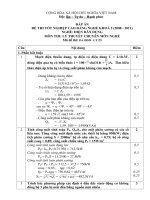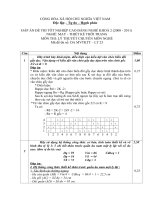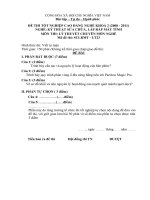PASSAGE 23
Bạn đang xem bản rút gọn của tài liệu. Xem và tải ngay bản đầy đủ của tài liệu tại đây (90.05 KB, 6 trang )
PASSAGE 23
► Read the following passage and mark the letter A, B, C, or D on your answer sheet to
indicate the correct answer to each of the questions from I to 10.
Some animal behaviorists argue that certain animals can remember past events, anticipate future
ones, make plans and choices, and coordinate activities within a group. These scientists, however, are
cautious about the extent to which animals can be credited with conscious processing.
Explanations of animal behavior that leave out any sort of consciousness at all and ascribe
actions entirely to instinct leave many questions unanswered. One example of such unexplained
behavior: Honeybees communicate the sources of nectar to one another by doing a dance in a
figure-eight pattern. The orientation of the dance conveys the position of the food relative to the
sun's position in the sky, and the speed of the dance tells how far the food source is from the
hive. Most researchers assume that the ability to perform and encode the dance is innate and
shows no special intelligence. But in one study, when experimenters kept changing the site of the
food source, each time moving the food 25 percent father from the previous site, foraging
honeybees began to anticipate where the food source would appear next. When the researchers
arrived at the new location, they would find the bees circling the spot, waiting for their food. No
one has yet explained how bees, whose brains weigh four ten-thousandths of an ounce, could
have inferred the location of the new site.
Other behaviors that may indicate some cognition include tool use. Many animals, like the
otter who uses a stone to crack mussel shells, are capable of using objects in the natural
environment as rudimentary tools. One researcher has found that mother chimpanzees
occasionally show their young how to use tools to open hard nuts. In one study, chimpanzees
compared two pairs of food wells containing chocolate chips. One pair might contain, say, five
chips and three chips, the other four chips and three chips. Allowed to choose which pair they
wanted, the chimpanzees almost always chose the one with the higher total, showing some sort
of summing ability. Other chimpanzees have learned to use numerals to label quantities of items
and do simple sums.
Question 1: What does the passage mainly discuss?
A.
Observations that suggest consciousness in animal behavior.
B.
The use of food in studies of animal behavior.
C.
The role of instinct in animal behavior.
D.
Differences between the behavior of animals in their natural environments and in
laboratory experiments.
Question 2: Which of the following is NOT discussed as an ability animals are thought to have?
A.
Communicating emotions
B.
Remembering past experiences
C.
Selecting among choices
D.
Anticipating events to come
– Website chuyên đề thi – tài liệu file word mới nhất
1
Question 3: What is the purpose of the honeybee at a site?
To determine the quality of food at a site
A.
B.
To increase the speed of travel to food sources
C.
To identify the type of nectar that is available
To communicate the location of food
D.
Question 4: The word "yet" is closest in meaning to________.
A. however
B. generally
C. since
D. so far
Question 5: What did researchers discover in the study of honeybees discussed in paragraph 2?
Bees are able to travel at greater speeds than scientists thought.
A.
B.
The bees were able to determine in advance where scientists would place their
C.
Changing the location of food caused bees to decrease their dance activity.
food.
The bees could travel 25% farther than scientists expected.
D.
Question 6: It can be inferred from the passage that brain size is assumed to_________.
be an indicator of cognitive ability
A.
be related to food
B.
consumption
correspond to levels of
C.
activity
vary among Individuals within a species
D.
Question 7: Why are otters and mussel shells included in the discussion in paragraph 3?
To provide that certain species demonstrate greater ability in tool use than other
A.
species.
B.
To provide an example of tool use among animals.
C.
To show that animals are very good at using objects in their habitat.
To provide an example of the use of weapons among animals.
D.
Question 8: The word "rudimentary" in meaning to _______________.
A. technical
B. basic
C. superior
D. original
Question 9: The phrase "the one" refer to the ______________________,
A. chimpanzee
B. pair
C. ability
D. study
Question 10: Scientists concluded from the experiment with chimpanzees and chocolate chips that
chimpanzees ________________.
A. prefer
B.
C.
to work in pairs or groups
have difficulty selecting when given choices
lack abilities that other primates have
D. exhibit
behavior that indicates certain mathematical abilities
– Website chuyên đề thi – tài liệu file word mới nhất
2
ĐÁP ÁN
PASSAGE 23
Question 1:
Nội dung chính của bài viẽt:
A.Những quan sát thể hiện ý thức trong hành vi của động vật.
B.Việc sử dụng thức ăn trong những nghiên cứu về hành vi cùa động vật.
C.Vai trò cùa bản năng trong hành vi của động vật.
D.Sự khác nhau giữa hành vi của động vật trong môi trường tự nhiên của chúng và trong phịng
thí nghiệm.
These scientists, however, are cautious about the extent to which animals can be credited with
conscious processing.
Explanations of animal behavior that leave out any sort of consciousness at all and ascribe
actions entirely to instinct leave many questions unanswered. One example of such unexplained
behavior: Honeybees communicate the sources of nectar.
Other behaviors that may indicate some cognition include tool use
=> A (Bài viết đưa ra những ví dụ cụ thể về khả năng nhận thức của động vật khi các nhà nghiên
cứu hành vi động vật quan sát được)
Question 2:
Which of the following is NOT discussed as an ability animals are thought to have? (Điều nào
sau đây không được thảo luận như là khả năng động vặt có?)
Some animal behaviorists araue that certain animals can remember past events, anticipate future
ones make plans and choices, and coordinate activities within a group. (Các nhà nghiên cứu hành vi
của động vật nhận định rằng một vài lồi động vật có thể nhớ được những sự kiện trong quá khứ,
đoán trước được sự kiện tương lai, lên kể hoạch và đưa ra lựa chọn, và hợp tác hành động trong một
nhóm)
=> A
Question 3:
Mục đích cùa loài ong mật ờ 1 địa điểm là
A. để xác định chất lượng thức ăn ở địa điểm đó
B. để tăng tốc độ đi tới nguồn thức ăn
C. để xác định loại mật hoa đang có
D. để giao tiếp vể vị tri của nguổn thức ăn
– Website chuyên đề thi – tài liệu file word mới nhất
3
Honeybees communicate the sources of nectar to one another by doing a dance in a figure- eight
pattern. The orientation of the dance conveys the position of the food relative to the sun's position in
the sky, and the speed of the dance tells how far the food source is from the hive.
=> D
Question 4:
No one has yet explained how bees,
- yet: chưa, vẫn chưa
- however: tuy nhiên
- generally: một cách chung, một cách khái quát
- since: từ khi
- so far: cho đến nay
=>D (Khơng ai cho đến nay có thế giải thích làm cách nào lồi ong..,) y
Question 5:
What did researchers discover in the study of honeybees discussed in paragraph 2? (Những nhà
nghiên cứu đã phát hiện ra điéu gì trong nghiên cứu vé loài ong mặt ở đoạn 2?)
A.
Loài ong có thể bay với tốc độ nhanh hơn nhứng nhà khoa học nghĩ
B.
Ong có thể xác định trước nơi các nhà khoa học đặt thức ăn
C.
Sự thay đổi về vị trí của thức ăn khiến cho ong giảm các hoạt động nhảy.
D.
Lồi ong có thể bay xa hơn 25% so với những gì các nhà khoa học mong đợi.
... when experimenters kept changing the site of the food source, each time moving the food 25
percent father from the previous site, foraging honeybees began to anticipate where the food source
would appear next When the researchers arrived at the new location, they would find the bees
circling the spot, waiting for their food, (khi các thí nghiệm thay đổi vị trí nguỏn thửc ăn, mỏi lần di
chuyển thức ăn xa hơn 25% so với vị trí ban đáu, ong mật thợ bẳt đáu đốn trước vị trí tiếp theo.
Khi các nhà nghiên cứu đến địa điểm mới, họ đã thấy những con ong bay xung quanh địa điểm, chờ
đợi thức ăn của chúng. => chúng có khả năng bay xa hơn 25% so với mong đợi)
=> D
Question 6:
Có thể suy luận từ bài viết rằng kích thước não được cho rằng
A.
B.
là dấu hiệu chỉ ra khả năng nhận thức
liên quan tới việc tiêu thụ
thức ăn
C.
liên quan đến mức độ của
hoạt động
D.
khác nhau giữa các cá thể trong loài
No one has yet explained how bees, whose brains weigh four ten-thousandths of an ounce could
have inferred the location of the new site. (Vân chưa ai có thể giải thích được bằng cách nào lồi
ong, với bộ não chi nặng 4 10/1000 của 1 ounce, có thể suy luận ra vị trí của địa điểm mớì => kích
thước não có thể là dấu hiệu chỉ ra khà năng nhận thức của động vật)
=> A
– Website chuyên đề thi – tài liệu file word mới nhất
4
Question 7:
Tại sao con rái cá và con trai được thảo luận ở đoạn 3?
A.
Để cung cấp thông tin rằng một vài loài cụ thể thể hiện khả năng sử dụng cơng cụ
tót hơn các lồi khác
B.
Để cung cấp ví dụ về việc sử dụng cơng cụ gìửa các lồi động vật
C.
Để thể hiện rằng động vật rất giỏi sử dụng các đố vật trong mơi trường sóng
của chủng
Để cung cấp một ví dụ vé việc sử dụng vũ khí giữa các loài động vật Many
animals, like the otter who uses a stone to crack mussel shells, are capable of using objects in the
natural environment as rudimentary tools.
D.
=> B
Questions 8:
- to monitor something: to watch and check something over a period of time in order to see how
it develops, so that you can make any necessary changes (theo từ điền Oxford Learner's Dictionary)
(theo dõi và kiểm tra cái gì trong suốt 1 khoảng thời gian để xem quá trình phát triển và tạo những
thay đổi cẩn thiết) .
=> C
Question 9:
Allowed to choose which pair they wanted, the chimpanzees almost always chose the one
with the higher total, showing some sort of summing ability.
=> B
Question 10:
Scientists concluded from the experiment with chimpanzees and chocolate chips that
Chimpanzees ___________. (Các nhà khoa học đã rút ra kết luận từ thí nghiệm với tinh tinh và sơ cơ
la rằng lồi tinh tinh ___________ )
A.
thích làm việc theo cặp và nhóm
B.
gặp khó khăn khi đưa ra lựa chọn
C.
thiếu khả năng mà những loài động vật linh chưởng khác có
D.
thể hiện hành vi chỉ ra những khả năng toán học nhất định
One pair might contain, say, five chips and three chips, the other four chips and three chips.
Allowed to choose which pair they wanted, the chimpanzees almost always chose the one with
the higher total, showing some sort of summing ability
=> D
– Website chuyên đề thi – tài liệu file word mới nhất
5
Vocabulary
- animal behaviourist (n): nhà nghiên cứu hành vi động vật
- to anticipate (v): đốn trước, nhìn thấy trước
- to coordinate (v): phối hợp, hợp tác làm việc cũng nhau
- be cautious (adj): cần thận, thận trong
- credit (n): lòng tin, sự tinh/ danh tiếng, danh vọng
- conscious (adj): biết rõ, tỉnh táo, có ý thức
- to leave out(v): bỏ qua, bỏ sót cái gì
- ascribe (n) smt to smt: đổ tại, đổ cho/ gán cho là cùa ai.
- instinct (adj): bản năng
- nectar (n): mật hoa
- to convey (v): truyền đạt, truyén tải
- hive (n): tổ ong
- to encode (v): mã hỏa, ghi lại thành mật mã
- be innate (adj): bẩm sinh
- cognition (n): trí thức, sự hiểu biết, nhận thức
- otter (n): con rái cá
- to crack (v): làm nứt, làm vỡ
- mussel (n): (động vật học) con trai
- be rudimentary (adj): thô sơ
- numeral (n): số, chữ số/ (adj); thuộc chữ, thuộc số
– Website chuyên đề thi – tài liệu file word mới nhất
6









